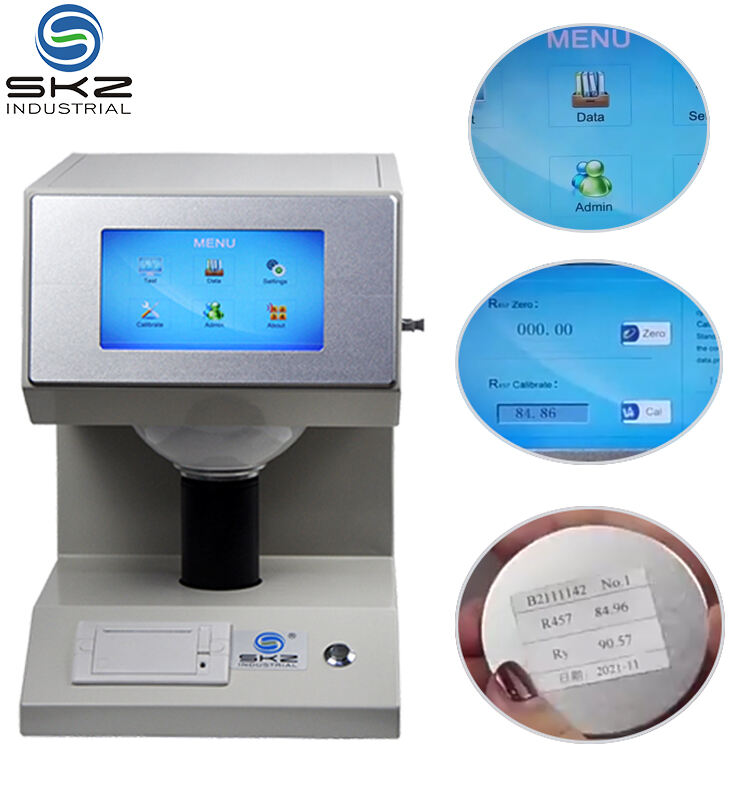Fundamental Principle of Differential Scanning Calorimetry (DSC)
Differential Scanning Calorimetry, commonly known as DSC, basically tracks how much heat flows into or out of a material compared to an empty container as temperatures rise. Materials tend to act differently when they go through changes like melting solid stuff into liquid, forming crystals from melt, or shifting from rigid to flexible states. During these transformations, they either take in heat or give it off, which creates noticeable shifts in the overall heat pattern. Special instruments pick up on these tiny changes and translate them into valuable data about things like how much energy is involved in reactions, whether substances will stay stable at certain temps, and exactly at what point different phases occur according to recent research published in the Journal of Thermal Analysis last year.
Heat Flux vs. Power Compensation: Types of DSC and Their Operational Differences
There are essentially two types of differential scanning calorimetry setups out there: heat flux and power compensation models. With heat flux DSC, samples and references share the same furnace chamber where temperature variations get detected through arrays of thermocouples positioned strategically around the setup. Labs often go this route because it’s budget friendly and works well enough for most standard polymer testing needs. The other approach, power compensation DSC, takes things further by giving each sample its own dedicated furnace. These systems constantly tweak their energy inputs to keep temperatures matching across chambers. What makes these devices stand out? They can detect incredibly small changes down to just 0.1 microwatts, which means they pick up on those tricky fast processes or subtle material transformations that might otherwise slip past less sensitive equipment, especially during things like monitoring how epoxies actually cure over time.
Understanding Thermal Transitions: Glass Transition, Melting, and Crystallization
DSC detects three primary thermal events:
- Glass Transition Temperature (Tg): A step change in heat capacity indicating the softening of amorphous materials like plastics.
- Melting Point (Tm): An endothermic peak marking the breakdown of crystalline structure in polymers or metals.
- Crystallization Peaks: Exothermic signals revealing how quickly semi-crystalline materials form ordered structures upon cooling.
These transitions inform decisions about material flexibility, processing conditions, and formulation stability. For example, a 5°C drop in Tg may indicate plasticizer loss in PVC, affecting product durability.
Measuring Enthalpy Changes and Detecting Low-Energy Transitions
To calculate enthalpy changes (ΔH), scientists integrate the area underneath those thermal peaks seen on a DSC curve. When we see a big ΔH value during melting, say around 200 joules per gram, that usually means there’s quite a bit of crystallinity present in the polymer material. On the flip side, those tiny exothermic signals, maybe something like 1.2 J/g, often point to incomplete curing processes happening in various resin systems. The latest generation of analytical equipment has gotten really good at picking up even the smallest energy transitions down to about half a millijoule. This capability makes it possible to study all sorts of materials that were previously too difficult to analyze, including ultra thin film layers, microscopic coatings applied to surfaces, and other miniature sample types where traditional methods just don't work well enough.
Limitations in Accuracy for Weak or Overlapping Thermal Events
DSC offers pretty good accuracy around plus or minus 0.1 degrees Celsius, but it still has trouble picking up those really small transitions below about 0.2 joules per gram. Think about things like secondary relaxations happening in elastomer materials. When different processes happen at the same time, say when plastic starts to melt while also breaking down in recycled products, the results get all mixed up and hard to interpret. That's where Modulated DSC comes in handy. This technique adds a wave-like pattern to the temperature changes during testing. What happens is that we can tell apart what's happening reversibly, like glass transition temperatures, from stuff that isn't reversible, such as chemical curing or material breakdown. The end result? Much clearer data points and better overall resolution in our measurementsInterpreting DSC Thermograms: Analyzing Thermal Events and Quantifying Material Properties
Reading DSC Curves: Identifying Tg, Tm, and Crystallization Peaks
DSC thermograms basically track how much heat flows through a sample as it heats up, showing when materials undergo important changes. When looking at these graphs, we typically see the glass transition point as a sort of step-like shift in the baseline reading. Melting events tend to create upward spikes since they absorb heat (that's endothermic), whereas crystallization shows as downward spikes because it releases heat (exothermic). Take polyethylene for example this common semicrystalline polymer usually melts somewhere around 110 to 135 degrees Celsius, though exactly where depends on how its molecules are arranged. These days, most advanced DSC equipment can measure glass transition temperatures within just 0.1 degree accuracy. That kind of precision matters a lot in fields like pharmaceuticals where small temperature differences can affect drug stability, and also in developing new plastics for various industrial applications.
Quantitative Analysis: Calculating Enthalpy, Purity, and Degree of Cure
Differential scanning calorimetry works by looking at peak areas to figure out those enthalpy changes (ΔH) that happen during physical or chemical processes. When it comes to thermoset materials, comparing ΔH values between samples gives us an idea of how much they've actually cured, usually within about 2% accuracy according to ASTM standards. Speaking of purity checks, there's this handy thing called the van't Hoff equation that helps relate melting point drops to impurity concentrations down to just half a mole percent. This level of detail is super important for making sure drugs meet quality requirements in the pharmaceutical industry.
Detecting Curing Behavior in Thermosets and Cross-Linking Reactions
Epoxy and polyurethane curing generate exothermic peaks whose shape and onset reveal reaction kinetics and activation energy. Shoulder peaks or asymmetric curves often indicate multi-stage cross-linking, helping engineers optimize cure cycles and avoid under- or over-curing.
Challenges in Deconvolution of Overlapping Thermal Events
Complex materials may display overlapping transitions—such as melting coinciding with oxidative degradation—complicating interpretation. Baseline drift and noise further hinder accurate integration. Sophisticated curve-fitting tools and MDSC help resolve these issues by isolating individual contributions.
Modulated DSC (MDSC): Enhancing Resolution in Complex Materials
MDSC applies a modulated heating profile (e.g., linear ramp with sinusoidal oscillation) to separate total heat flow into reversing (heat capacity-related) and non-reversing (kinetic) components. This improves detection of weak transitions like Tg in filled rubber compounds by up to 40%, according to 2022 polymer studies.
Key Applications of Differential Scanning Calorimeter in Industry and Research
DSC is a cornerstone technique for thermal characterization across sectors, providing insights into material behavior under controlled heating or cooling.
Polymers and plastics: thermal characterization and degradation analysis
DSC delivers essential data on Tg, Tm, crystallinity, and oxidative stability. Degradation onset temperatures are measurable within ±0.5°C, supporting predictions of long-term performance under thermal stress. This information guides processing parameters and service life estimates.
Compliance with ASTM standards for reproducible plastics testing
To ensure consistency, laboratories follow ASTM E794 (melting/freezing temperatures) and ASTM E2716 (oxidative induction time). Standardized procedures—including 10°C/min heating rates and defined purge gas flows—reduce inter-lab variability by up to 30%.
Pharmaceuticals: polymorphism, formulation stability, and drug development
Polymorphic forms of active pharmaceutical ingredients (APIs) exhibit different thermal profiles, impacting solubility and bioavailability. DSC identifies these forms early in development. A 2024 report shows ΔH measurements correlate with excipient compatibility at 92% accuracy compared to accelerated stability tests.
Food science: fat crystallization, shelf-life prediction, and quality control
In chocolate production, DSC analyzes cocoa butter crystallization to fine-tune tempering and prevent fat bloom. It also detects starch retrogradation with sensitivity down to 0.1 J/g, guiding texture and shelf-life optimization in baked goods.
Material purity assessment and performance evaluation across industries
Metallurgists use DSC to monitor alloy phase transformations, while adhesive formulators assess cure kinetics to refine bonding schedules. In pharmaceuticals, melting point depression analysis achieves 99.8% sensitivity in detecting trace impurities.
FAQ
What is Differential Scanning Calorimetry (DSC)?
Differential Scanning Calorimetry (DSC) is a method that measures how much heat flows into or out of a material as it undergoes temperature changes, helping in the analysis of phase transitions, stability, and energy involvement in reactions.
What are the primary types of DSC used?
The two main types of DSC setups are heat flux and power compensation models, each detecting temperature variations and energy inputs through different mechanisms.
What are the applications of DSC in industries?
DSC is widely applied in polymers, pharmaceuticals, food science, and material purity assessments for thermal characterization, degradation analysis, formulation stability, and quality control.
Table of Contents
- Fundamental Principle of Differential Scanning Calorimetry (DSC)
- Heat Flux vs. Power Compensation: Types of DSC and Their Operational Differences
- Understanding Thermal Transitions: Glass Transition, Melting, and Crystallization
- Measuring Enthalpy Changes and Detecting Low-Energy Transitions
-
Limitations in Accuracy for Weak or Overlapping Thermal Events
- Reading DSC Curves: Identifying Tg, Tm, and Crystallization Peaks
- Quantitative Analysis: Calculating Enthalpy, Purity, and Degree of Cure
- Detecting Curing Behavior in Thermosets and Cross-Linking Reactions
- Challenges in Deconvolution of Overlapping Thermal Events
- Modulated DSC (MDSC): Enhancing Resolution in Complex Materials
-
Key Applications of Differential Scanning Calorimeter in Industry and Research
- Polymers and plastics: thermal characterization and degradation analysis
- Compliance with ASTM standards for reproducible plastics testing
- Pharmaceuticals: polymorphism, formulation stability, and drug development
- Food science: fat crystallization, shelf-life prediction, and quality control
- Material purity assessment and performance evaluation across industries
- FAQ

